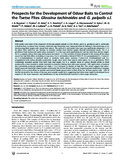| dc.contributor.author | Rayaisse, J. B. | |
| dc.contributor.author | Kaba, Tirados,D. | |
| dc.contributor.author | Dewhirst, S. Y. | |
| dc.contributor.author | Logan, J. G. | |
| dc.contributor.author | Diarrassouba, A. | |
| dc.contributor.author | Salou, E. | |
| dc.contributor.author | Omolo, M. O. | |
| dc.contributor.author | Solano, P. | |
| dc.contributor.author | Lehane, M. J. | |
| dc.contributor.author | Pickett, J. A. | |
| dc.contributor.author | Vale, G. A | |
| dc.contributor.author | Torr, S. J. | |
| dc.contributor.author | Esterhuizen, J. | |
| dc.date.accessioned | 2021-07-09T12:39:29Z | |
| dc.date.available | 2021-07-09T12:39:29Z | |
| dc.date.issued | 2010-03-16 | |
| dc.identifier.uri | https://doi.org/10.1371/journal.pntd.0000632 | |
| dc.identifier.uri | https://journals.plos.org/plosntds/article?id=10.1371/journal.pntd.0000632 | |
| dc.identifier.uri | http://r-library.mmust.ac.ke/123456789/1774 | |
| dc.description.abstract | Field studies were done of the responses of Glossina palpalis palpalis in Côte d'Ivoire, and G. p. gambiensis and G. tachinoides in Burkina Faso, to odours from humans, cattle and pigs. Responses were measured either by baiting (1.) biconical traps or (2.) electrocuting black targets with natural host odours. The catch of G. tachinoides from traps was significantly enhanced (∼5×) by odour from cattle but not humans. In contrast, catches from electric targets showed inconsistent results. For G. p. gambiensis both human and cattle odour increased (>2×) the trap catch significantly but not the catch from electric targets. For G. p. palpalis, odours from pigs and humans increased (∼5×) the numbers of tsetse attracted to the vicinity of the odour source but had little effect on landing or trap-entry. For G. tachinoides a blend of POCA (P = 3-n-propylphenol; O = 1-octen-3-ol; C = 4-methylphenol; A = acetone) alone or synthetic cattle odour (acetone, 1-octen-3-ol, 4-methylphenol and 3-n-propylphenol with carbon dioxide) consistently caught more tsetse than natural cattle odour. For G. p. gambiensis, POCA consistently increased catches from both traps and targets. For G. p. palpalis, doses of carbon dioxide similar to those produced by a host resulted in similar increases in attraction. Baiting traps with super-normal (∼500 mg/h) doses of acetone also consistently produced significant but slight (∼1.6×) increases in catches of male flies. The results suggest that odour-baited traps and insecticide-treated targets could assist the AU-Pan African Tsetse and Trypanosomiasis Eradication Campaign (PATTEC) in its current efforts to monitor and control Palpalis group tsetse in West Africa. For all three species, only ∼50% of the flies attracted to the vicinity of the trap were actually caught by it, suggesting that better traps might be developed by an analysis of the visual responses and identification of any semiochemicals involved in short-range interaction. | en_US |
| dc.language.iso | en | en_US |
| dc.publisher | PLOS ONE | en_US |
| dc.subject | Prospects,Development , Odour, Baits, Control , Tsetse, Flies, Glossina, tachinoides, G. palpalis s.l. | en_US |
| dc.title | Prospects for the Development of Odour Baits to Control the Tsetse Flies Glossina tachinoides and G. palpalis s.l. | en_US |
| dc.type | Article | en_US |

